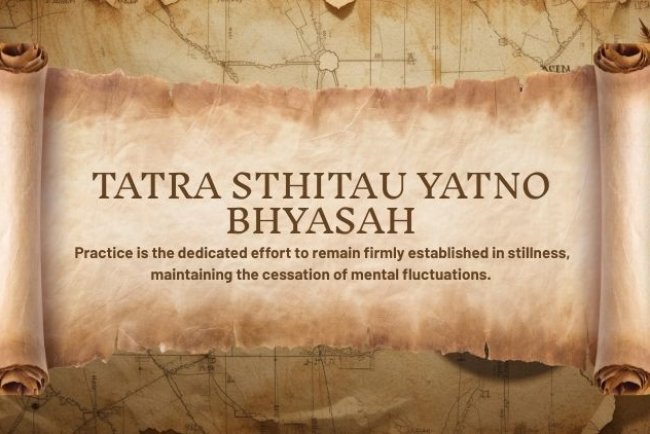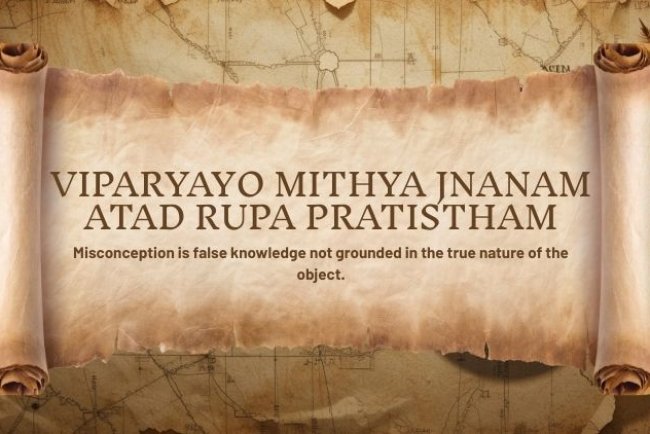Yoga Sutra 1.27: Tasya vacakah pranavah

As Patanjali unfolds the Yoga Sutras, the concept of Isvara—the Supreme Self, untouched by afflictions, karma, or the limits of time—emerges as a central theme. In the previous sutra (1.26), he introduces Īśvara as the eternal guru, the teacher of even the earliest seers. Naturally, a question arises: How can the yogi become aware of this eternal presence?
Patanjali answers this beautifully in Yoga Sutra 1.27: Tasya Vacakah Pranavah, which translates to:
“His expression is Om.”
In this one profound yet simple sentence, Patanjali encapsulates the essence of the yoga tradition. The sacred sound Om (Pranava) is presented as the key to aligning oneself with Isvara—the eternal teacher. It is not merely a sound, but a living vibration that bridges the human and the divine, the limited and the limitless.
Through this sutra, Patanjali introduces sound as the medium between form and formlessness. By declaring Om as the vacaka—the name, symbol, or verbal expression—of Isvara, he gives practitioners a tangible way to connect with the unnameable and infinite reality.
Thus, the chanting, contemplation, and meditation on Om become not just a ritual, but a spiritual practice—a means to awaken awareness of the eternal Self within.
What Does Yoga Sutra 1.27 Say?
The sutra “Tasya Vācakaḥ Praṇavaḥ” translates as:
“The word that expresses Him (Isvara) is the sacred syllable Om.”
Here, Patanjali offers not a philosophical abstraction, but a direct and practical method for spiritual connection. Rather than relying on theories or concepts, he gives the seeker something tangible—the repetition and contemplation of Om. Through this simple yet profound practice, the yogi cultivates devotion, discernment, and awareness of the unchanging Self.
Om is not merely a sound; it is a vibration of wholeness, encompassing creation, preservation, and dissolution. It represents the origin, journey, and culmination of all existence. By establishing Om as the vacaka—the verbal expression of Isvara—Patanjali reveals a sacred bridge between the human mind and universal consciousness.
Through chanting and meditating on Om, the yogi tunes inward, aligning with the eternal presence that underlies all life.
Yoga Sutra 1.27 – Translation
Sanskrit: तस्य वाचकः प्राणवः॥२७॥
Transliteration: Tasya Vacakah Pranavah
Word-for-Word Translation:
-
tasya — His (the special Self, i.e., Isvara)
-
vacakaḥ — that which expresses, signifies, or names
-
pranavah — the sacred syllable Om, the primal sound
Full Translation:
“The syllable Om is His name.”
Meaning of Praṇava (Om)
The word Praṇava comes from the root nu (to praise) with the prefix pra (intensity). Thus, Praṇava literally means “that which is deeply praised” or “the original sacred sound.” In yogic philosophy, Praṇava refers to the syllable Om (A–U–M)—the primordial vibration that pervades all existence.
Om is considered the source of all sound, the vibration through which creation arises, is sustained, and finally dissolves. To chant Om is to tune one’s body, mind, and spirit into harmony with the rhythm of the universe. It prepares the practitioner for deeper states of meditation and inner stillness.
In the context of this sutra, Om serves as the linguistic and sonic gateway to Isvara. Just as a name connects us to a person, Om connects the seeker to the infinite reality beyond form and concept. By repeating this sacred sound with awareness, one does not worship a mere vibration, but invokes the presence of the highest consciousness within.
Why Om is the Expression of Īśvara
Patanjali’s selection of Om as the vācaka—the verbal expression or symbol—of Īśvara is deeply intentional and rooted in both philosophy and practice. There are several profound reasons behind this choice:
-
Universality
Om transcends all boundaries—religious, linguistic, and cultural. It is a universal sound, recognized across spiritual traditions as a symbol of the divine presence that unites all beings.
-
Primordial Nature
Ancient texts describe Om as the first vibration of creation, the sound from which the entire cosmos emerged. It represents the underlying frequency that sustains all existence.
-
Sign of Completeness
The syllable Om consists of three distinct sounds—A, U, and M—which symbolize the three cosmic functions of creation, preservation, and dissolution. They also correspond to the three states of human experience: waking, dreaming, and deep sleep.
Beyond these lies Turīya, the silence following the chant of Om, representing pure consciousness, the unchanging reality beyond all forms. -
Practical Accessibility
Chanting Om requires no elaborate ritual or belief system. It is an immediate and experiential practice, accessible to all. Through mindful repetition, one can quiet the mind, awaken devotion, and align with the universal Self.
The Role of Sound in Yoga
Patanjali’s identification of sound as a gateway to the divine aligns with the broader Indian philosophical understanding that sabda (sound) is sacred. In the Vedic worldview, creation itself arises from vibration, and sound carries the power to transform consciousness.
By meditating on Om, the yogi attunes to the vibration of pure awareness. Unlike ordinary sounds that name external objects, Om names the unmanifest reality—that which cannot be seen but can be felt through resonance. This is what makes Om both a symbol and a practice of the infinite.
Yoga Sutra 1.27 is not meant to be analyzed endlessly—it is an invitation to practice. Here are simple ways to integrate Om into your daily sadhana (spiritual discipline):
1. Chanting Om Aloud
Chant slowly and deliberately, allowing the vibration to flow through the entire body.
-
The “A” begins deep in the throat.
-
The “U” moves through the chest.
-
The “M” closes at the lips, vibrating in the head.
Together, these merge into a single, harmonious sound that unites body, breath, and awareness.
2. Silent Repetition (Japa)
Mentally repeat Om during meditation. This inner vibration steadies the wandering mind, deepens concentration, and creates a quiet inner space for awareness to expand.
3. Om with the Breath
Synchronize Om with inhalation and exhalation. Let the breath carry the sound inward and outward, turning each breath into an act of mindful devotion.
4. Om in Daily Transitions
Chant Om before beginning work, study, or yoga practice. It anchors intention, centers attention, and harmonizes action with presence.
5. Om as Contemplation
Reflect on the deeper meaning of Om—as the sound of completeness, the name of Isvara, and the reminder of the ever-present Self within all things.
Advantages of Meditating on Om
In the following sutras (1.28–1.29), Patanjali elaborates that the chanting and contemplation of Om lead to mental clarity, removal of inner obstacles, and a deep connection with the Self. The practice of Om becomes both the path and the purifier.
Some of its key benefits include:
-
Focus and Concentration:
The rhythmic chanting of Om gathers the scattered thoughts of the mind and anchors them into one-pointed awareness.
-
Inner Tranquility:
The vibration of Om calms the nervous system, dissolving layers of tension, anxiety, and restlessness.
-
Spiritual Harmonization:
Through the resonance of this sacred sound, the practitioner becomes attuned to higher states of consciousness and inner balance.
-
Humility and Surrender:
The practice of Om nurtures the art of surrender—an acknowledgment of something vast and divine beyond the personal ego.
Vacakah – The Power of Naming
The term vacakah means “that which names or expresses.” In yogic philosophy, a name is not a mere label—it carries vibrational power that links the word with the reality it represents.
When Patanjali identifies Om as the vacaka of Isvara, he implies that chanting Om is not just symbolic—it is energetically connected to the divine reality it denotes.
Just as recalling the name of a beloved evokes their presence in the heart, remembering and repeating Om awakens the awareness of the deathless Self within. Through this sacred link between sound and essence, speech and transcendence, Om becomes a bridge to the eternal.
The Continuity of Tradition
Patanjali’s association of Isvara with Om is not an innovation but a continuation of timeless wisdom. Long before the Yoga Sutras were composed, the Upanisads had already identified Om as the sound-symbol of Brahman, the ultimate reality. By weaving this sacred syllable into his system, Patanjali seamlessly connects yoga with the broader spiritual heritage of India—honoring its roots while giving it a practical and meditative focus.
Through this integration, the Yoga Sutras become not only a manual of self-realization but also a bridge between Vedic philosophy and yogic experience—a living thread in the fabric of India’s spiritual tradition.
How Sutra 1.27 Enriches Practice
This sutra carries both philosophical depth and practical guidance, offering timeless wisdom for modern practitioners.
-
Simplicity with Depth
While the Yoga Sutras explore profound philosophical concepts, Patanjali distills the essence of devotion and concentration into one simple act—chant Om.
-
Embodied Spirituality
The vibration of Om is not just heard but felt throughout the body, making spirituality a direct, lived experience rather than an abstract idea.
-
Union of Devotion and Discipline
Chanting Om unites bhakti (devotion) with abhyasa (steady practice), balancing heartfelt surrender with mindful effort. -
Timeless Accessibility
From the sages of ancient India to the modern seeker, Om remains a universal and ever-accessible practice, inviting all to reconnect with the eternal consciousness within.
Conclusion
Yoga Sutra 1.27 — Tasya Vacakah Pranavah — is brief, yet profoundly powerful. In just a few words, Patanjali bridges the infinite and the finite, the unutterable and the expressible, by declaring that Om is the word of Isvara.
This sutra serves as both a devotional affirmation and a practical tool. It reminds us that the ultimate reality, though beyond name and form, becomes accessible through the sacred vibration of Om. By chanting, meditating, and reflecting upon this sound, the seeker attunes to the eternal teacher—the guru within.
When we recite Om, we are not merely producing a sound—we are tuning into the primordial vibration of existence itself. Each chant calls forth presence, release, and unity, reconnecting us with the timeless essence that underlies all life.
Thus, Sutra 1.27 is both a reminder and a practice: the eternal is not distant—it resonates within us, waiting to be realized in a single, sacred syllable.
What's Your Reaction?


























